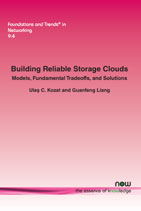Building Reliable Storage Clouds: Models, Fundamental Tradeoffs, and Solutions
By Ulas C. Kozat, Huawei R&D, ulas.kozat@huawei.com | Guanfeng Liang, LinkedIn, gliang@linkedin.com
Abstract
Distributed storage has been an active research area for decades. With the proliferation of cloud computing, there has been a rejuvenated interest in two perspectives. The first perspective is seen through the lenses of the cloud providers: how should we build global storage services for cloud hosted services and applications at scale with high reliability and availability guarantees, but also in a cost effective way? The second perspective is seen through the lenses of the service providers that utilize public clouds: how can we achieve high I/O performance over cloud storage within a cost budget? In this manuscript, we first present various kinds of distributed storage systems, their operational characteristics and the key techniques to improve their performance. We then focus on cloud storage, exclusively. Cloud storage has massive scales with the promise to provide as much storage capacity as their tenants demand. Cloud providers also promise very high durability, availability, and I/O performance. In this context, we cover the fundamental tradeoffs between storage efficiency and network bandwidth as well as I/O throughput and latency. Erasure codes play an essential role in these tradeoffs and, thus, we also present their design and usage in the context of cloud storage broadly. We pay particular attention on various queuing models and the corresponding performance analysis in the presence of coded storage. We provide exact and approximate solutions under various settings and assumptions. We describe optimal or near-optimal scheduling and coding strategies that are established based on these analyses.
Building Reliable Storage Clouds: Models, Fundamental Tradeoffs, and Solutions
With the proliferation of cloud computing, there has been a rejuvenated interest in two aspects of distributed computing. The first perspective is seen through the eyes of the cloud providers, and asks: how should we build global storage services for cloud hosted services and applications at scale with high reliability and availability guarantees in a cost effective way? The second perspective is seen through the eyes of the service providers that use public clouds, and asks: how can we achieve high I/O performance over cloud storage within a cost budget?
Building Reliable Storage Clouds presents various distributed storage systems, their operational characteristics, and the key techniques to improve their performance. The main focus is however on cloud storage. Cloud storage has massive scalability with the promise to provide as much storage capacity as their users demand. Cloud providers also promise very high durability, availability, and I/O performance. In this context, the monograph analyses the fundamental tradeoffs between storage efficiency and network bandwidth as well as I/O throughput and latency. Erasure codes play a significant role in determining the trade-offs, and, hence, the survey covers their design and use, paying particular attention to the queuing models and performance analysis.
This survey will be of interest to all researchers, students and engineers working on distributed storage systems.
